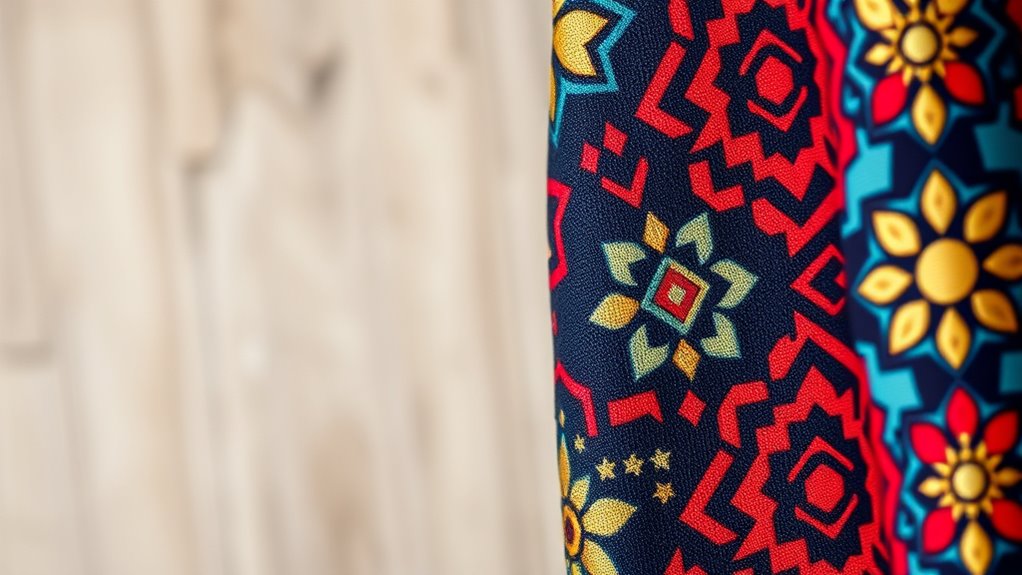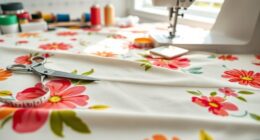To design a statement print using the rule of thirds, start by dividing your canvas into a 3×3 grid. Place your main message or focal points along the grid lines or at the intersections for maximum impact. Use bold, clear fonts and vibrant colors to emphasize key words, aligning them with the grid for balanced composition. Keep experimenting with placement, color, and typography to create a design that captures attention and feels intentional—exploring these principles further will help you craft more compelling visuals.
Key Takeaways
- Position key message elements along grid lines or at intersections for maximum visual impact.
- Use bold, readable typography placed strategically on the thirds to draw attention.
- Select color palettes that highlight focal points, placing vibrant hues at intersections or lines.
- Balance design components to create harmony, leveraging the rule to guide element placement.
- Experiment with typography styles and color schemes while maintaining flexibility to enhance composition.

The rule of thirds is a powerful guideline that can help you create visually striking statement prints. By dividing your design into nine equal parts with two horizontal and two vertical lines, you gain a framework to position your key elements for maximum impact. When designing a statement print, your typography choices are essential; selecting bold, clear fonts that stand out ensures your message is easily conveyed. You want your typography to complement the overall composition, so consider how font weight, size, and style interact with the placement dictated by the rule of thirds. Placing your main text or focal words along these lines or at their intersections naturally draws the viewer’s eye, making the message memorable. Understanding visual hierarchy helps you prioritize elements effectively within your design. Color palettes also play a critical role in harnessing the power of the rule of thirds. The right combination of colors can enhance the visual hierarchy, making the key elements pop. For instance, a high-contrast color scheme—like black and white or bold reds and blues—can emphasize the focal points. Alternatively, harmonious pastel palettes can evoke a softer, more subtle impact. When applying the rule of thirds, think about the emotional tone you want to set and choose your colors accordingly. Placing vibrant hues at the intersections or along one third line can create visual interest and balance, guiding the viewer’s gaze naturally through the design. As you work, remember that the rule of thirds isn’t a strict rule but a flexible guideline. Feel free to experiment with different typography choices—such as combining serif and sans-serif fonts or using custom lettering—to see what best complements your overall composition. Similarly, tweak your color palettes to find a scheme that enhances your message without overwhelming it. When you position your design elements thoughtfully along these grid lines, you create a harmony that feels both intentional and engaging. This strategic placement allows your statement print to command attention, ensuring your message resonates with viewers. Ultimately, mastering the use of the rule of thirds involves balancing your typography choices and color palettes to craft a compelling visual story. By thoughtfully aligning your key elements along these guiding lines, you make your statement print not only eye-catching but also cohesive and impactful. You’ll find that this approach elevates your design, making it more dynamic and memorable. When you understand how to harness this simple yet powerful principle, your statement prints will stand out confidently—delivering your message with clarity and style.
Frequently Asked Questions
Can the Rule of Thirds Be Applied to Digital and Traditional Art?
You can definitely apply composition techniques like the rule of thirds to both digital and traditional art. This rule helps create visual balance and guides viewers’ eyes naturally across your artwork. Whether you’re working with digital tools or traditional media, using the rule of thirds enhances the overall composition, making your art more engaging. It’s a versatile technique that improves your visual storytelling in any artistic medium.
How Do I Choose the Right Colors for My Statement Print?
When choosing colors for your statement print, focus on creating color harmony to guarantee your design feels balanced. Use contrasting colors to make key elements stand out and catch attention. Think about the mood you want to evoke and pick colors that complement each other while maintaining good color contrast. Test different combinations until you find a vibrant, cohesive palette that effectively communicates your message.
What Software Tools Are Best for Designing With the Rule of Thirds?
You can use various software tools for designing with the rule of thirds. Composition tools like grid overlays in Adobe Photoshop or Canva help you align elements perfectly. These platforms also offer color palettes, making it easy to choose harmonious colors for your statement print. By leveraging these tools, you can create balanced, visually appealing designs that follow the rule of thirds and enhance your overall composition.
How Does Negative Space Impact a Statement Print’S Effectiveness?
Negative space plays a vital role in a statement print’s effectiveness by enhancing visual balance. When you use negative space wisely, it directs viewers’ attention to the main message, making it clearer and more impactful. You’ll notice that well-placed negative space prevents clutter, allowing the design to breathe. This creates a harmonious look that strengthens your overall message, making your statement print more compelling and easier to understand.
Are There Any Common Mistakes to Avoid When Applying the Rule of Thirds?
You should watch out for common composition errors, like focal point misplacement, when applying the rule of thirds. If you place your main element too far off-center or ignore the grid, your design can feel unbalanced or awkward. To avoid this, carefully align your focal point along the grid lines or at intersections, ensuring your statement print feels engaging and naturally draws the viewer’s eye without disrupting harmony.
Conclusion
By applying the rule of thirds, you create a balanced and visually appealing statement print. This technique guides the viewer’s eye naturally, making your message stand out. Fascinatingly, studies suggest that our brains are wired to find this composition most pleasing, confirming its effectiveness. So, next time you design, trust this ancient principle—it’s backed by psychology and art history alike. You’ll craft prints that not only look good but also resonate deeply with your audience.









